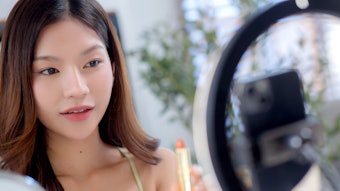With tremendous media exposure to international beauty standards, Indian teenagers are becoming more and more conscious of how they look. The increasing awareness about good skin and clear skin as an indicator of being in step with current fashion has meant that Indian teenagers are more than willing to try products that promise to improve the appearance of the skin.
Noting this opportunity, Johnson & Johnson has relaunched its Clean & Clear range of skin care products to the Indian market. The brand has offered a face wash for oil control, but, during the first few months of 2010, it has launched a complete skin care range—including spot treatment gel, face washes, oil control moisturizers and oil control wipes. In fact, the brand now offers a comprehensive range to deal with various teenage skin issues—including Daily Care Range, Oil Control Range and Acne Control Range. Johnson & Johnson has also launched a comprehensive Web site for Indian teens to offer tips on various skin issues.
Dermalogica is another brand that has focused on teens in a big way, launching large campaigns toward this segment. The brand’s Clean Start initiative and products were unveiled in January 2010 with much fanfare, including free makeovers and gift hampers to young adults and teens during a Dermalogica-sponsored college student-managed international film festival. Here again, the brand is now offering comprehensive skin care routines for day and night. Eight dual-action products that will allow teens to get great skin “on their own terms and not their mothers’ ” were among the initial offerings. Unlike the Johnson & Johnson range, the Dermalogica pricing is relatively high. However, a Dermalogica spokesperson claims that because all the products are free of mineral oil, SD alcohol, artificial colors and fragrances, the long-lasting impact of the products on skin will be safe and effective.
Excise Tax Proposed for Beauty Care
Looking well-groomed is going to get costlier in India. Recently, the Indian finance minister has proposed an excise tax hike on all personal care products—creams, lotions, shampoo, soap and hair oil, among the products cited. If this gets implemented, companies operating in India may look to a product price hike of up to 7%. A few Indian beauty brands—notably Emami, Godrej and Marico—have already announced their intentions to hike the prices of their products 3–7% by the end of May 2010. However, HUL (the Indian arm of Unilever), P&G and Dabur have not announced any plans for hiking the price of their beauty products. Spokespersons from these companies agree that, at a time when Indian consumers are reaching a high point in awareness about grooming and personal care, this kind of cost hike will negatively impact their buying decision. In fact, the impact might be more acute in markets in smaller towns where the consumers are more price-conscious. More and more global brands that market in larger Indian cities have been planning expansions into smaller towns with extended ranges of products, and the finance ministry’s tax is expected to hurt the business expansion of some brands in the smaller town markets.
The Body Shop Cuts Prices by 35%
Responding to Indian consumer demand for its products at more affordable prices, The Body Shop has reduced the prices of more than 600 of its product on Indian shelves by 35%. Since extending its presence in tier two cities such as Pune, Lucknow, Jaipur, Indore, Ludhiana (where consumers are far more cost-conscious), the brand felt the need to reduce prices further. In fact, a company spokesperson in India claims that this reduction is a follow-up of a similar initiative taken in 2009, when it had cut its prices. According to the source, the newest cut is in response to customer feedback as well as its strategy to attract new consumers. The brand launched the “The Body Shop Loves You” to announce the price cuts. As the company enters a new phase of growth and development of the brand in India, its focus is on ensuring its products are accessible and affordable. The prices of basic and its most popular skin care products have been cut 15–35%; makeup ranges 10–35%; and men’s ranges by 10–35%.
Hair Oils and Henna Still Popular Hair Care Categories
While the international brands that have entered India continue to launch and push modern day hair care and styling solutions such as conditioners, masks, serums, gels and sprays, the Indian market is still demanding traditional hair care products like hair oil and henna. In fact, hair oil is one of the fastest-growing categories, with increased penetration in rural markets as well. According to an Indian ayruvedic company Dabur spokesperson, its hair oil brands Vatika and Amla continue to show double-digit growth year on year, despite competition. The market remains hot as brands such as Parachute launch variants of its traditional coconut hair oil products. Interestingly, most variants have seen success in the market. According to the company spokesperson, massaging scalp and hair with oil remains a favorite hair care regimen for almost all Indian women. In fact, some women also like to use non-sticky versions of these products in lieu of post-shampoo conditioners. The concept of oiling is so popular that Garnier Fructis launched its Shampoo + Oil 2 in 1 variant, with claims to provide hair the goodness of fruit oils even as the consumer lathers up.
Henna also remains popular. Despite the fast growth rate of hair colorants in India, use of henna to tint hair and to condition the strands remain a favorite hair care practice. Indian brands such as Godrej Consumer Products, which also markets a non-henna hair color range, has aggressive marketing strategies for its henna products. The market for these products has been dominated by homegrown local and regional brands. However, with Godrej’s entry in to the henna segment, the market is taking a different shape. According to the COO of the company, 44% of women and men in the country’s north and west regions use henna. Godrej has created special blends of its henna to improve hair quality, as part of a strategy to differentiate through products that improve results. The company also sees henna as a great opportunity for both local and global hair care brands.
Expensive Spa Package
Despite the market slowdown of 2009 and the slow recovery, spa players in India are optimistic about the market. Some of the key spas attached to high-end hotels have introduced luxury packages that are very expensive by Indian market standards. Recently, Aura The Spa at Hotel The Park, announced one of the most expensive spa packages under its new branding—Aura Solitaire. The package, which starts at $2,200, is meant for couples looking for treatments that offer the ultimate sensorial indulgence. In fact, the treatment uses a careful selection of ingredients with aphrodisiacal properties—including diamond dust, caviar, chocolate, red wine and exotic blends of essential oils for what the spa calls a “once-in-a-lifetime experience.” This eight-hour pleasure begins with transportation in a luxury sedan and a chilled bottle of Döm Perignon. The treatment begins at the spa with a dip in the naturally enriched Evian spring water-filled hot tub, followed by a protein-rich caviar facial, a diamond dust body polish and warm chocolate body wrap. A customized aromatherapy massage with time in the hot tub, accompanied by red wine, is then followed by an exotic dinner, specially made using the client preferences.
While these treatments are exquisite, where they being offered are not known to be traditional places for big spenders in luxury therapies. According to sources, the offerings at the spa’s properties in the cities of Kolkata and Chennai indicate that target audiences are international travelers, luxury tourists and top executives. In fact, Chennai and Kolkata are increasingly becoming foreign tourist attractions, and places for business travelers, further indicating Aura is looking to tap into such a clientele.
Priyanka Bhattacharya is a writer and journalist covering the beauty, health and wellness industries in India. She is the contributing beauty features writer for several leading Indian women’s magazines.










